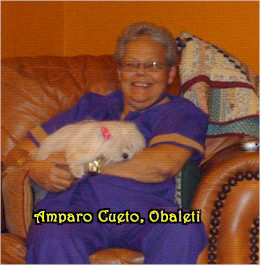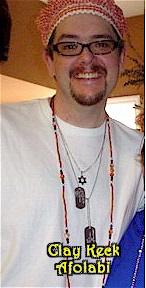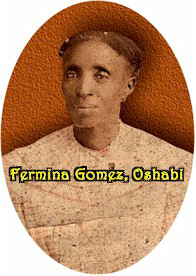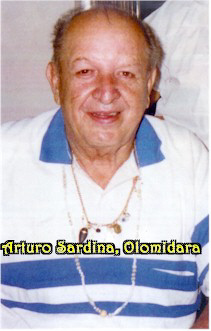 Ile Afolabí Family Tree
Ile Afolabí Family Tree
Ña Monserrate, Asinabí (Oni Yemojá) made
Arabia Oviedo Shangófunké (Oni Shangó), who made
Adela (La China) Alonso, Oduanlá (Olo Obatalá)
Arabia made Adela in the "Santo Parádo" tradition, in which Adela received
Obatalá and the warriors (or possibly just Elegba). She could make ebó for
people, read the dilogún, get possessed, but that is all. She could not make
Osha to people, nor could she pass on Orísha to others.
 Ña Caridad Argudín, Ajígoró (Olo
Oshósi), made
Ña Caridad Argudín, Ajígoró (Olo
Oshósi), made
Belen Gonzales, Ápoto, Oshún Aláibó (Olo Oshún), who made Luisa (La China)
Silvestre, Oshúnmiwá (Olo Oshún), who made Jose (Pata de Palo) Urquiola, Eshubí
(Omo Elegba).
Eshubí Jose gave Adela knife, and he put ashé in her head
and gave her the rest of the Oríshas, and ita, in which it was revealed that her
road of Obatalá was Oshanlá, the first time this was seen in Cuba. He brought
her initiation in line with the way the religion had become codified on the rest
of the island (which means the way that Timotea Albear- Ayai Lewu “Latuan” (Oni
Shango), Monserrate Oba Téro (Oni Shangó) and Ña Rosalía Efúnshe (Olo Oshósi)
had demanded that it be done) so that she could make Oshas and nobody could
question her Osha in any way. Adela then made (with Ojigbóna Alicia Adashé,
Olomidé [Oni Yemojá])
 Rigoberto
Rodriguez Duque, Oshúnyemí (Olo Oshún), who made (with Ojigbóna Arturo Sardiña,
Olomidára [Oni Yemojá])
Rigoberto
Rodriguez Duque, Oshúnyemí (Olo Oshún), who made (with Ojigbóna Arturo Sardiña,
Olomidára [Oni Yemojá])
Fína Víla, Alábunmí (Olo Obatalá), who made: Ernestina "Tita" Sardiña, Ogunyumí
(Oni Yemojá/Obatalá [Ogún]) who made (with Ojigbóna Migdália Pérez, Adufé [Olo
Obatalá])
Sandra Leon, Omidára (Oni Yemojá Ogúnte/Aganjú), who made
(with Ojigbóna Amparo Cueto, Obaletí, [Olo Obatalá Ajáguna/Nanú])
Shloma Rosenberg, Afolabí (Omo Olókun/Oni Yemojá Asesú/Shangó),
who made
Joseph Nurek, Obá Kuelé (Olo Obatalá Oba
Moro/Yemojá Ogúnte) – Sandra Leon, Omidára (Ojigbóna)
Sandy Denewith, Okúnláde (Oni Yemojá Mojelewu/Inle) – Amparo Cueto, Obaletí (Ojigbóna)
Steve Jurcak, Okúnfemí (Oni Yemojá Ogúnte/Asojano) – Sara Garcia, Okándeniyé (Ojigbóna)
 Kevyn Allen, Odofemí (Olo
Oshún Ibu Aña/Elegba) – Amparo Cueto, Obaletí (Ojigbóna)
Kevyn Allen, Odofemí (Olo
Oshún Ibu Aña/Elegba) – Amparo Cueto, Obaletí (Ojigbóna)
Calen Gibbs, Oshawéje (Olo Obatalá Ajáguna/Oshanlá) – Sandra Leon, Omidára (Ojigbóna)
Ellen Anglin, Oshún ni’kantomí/Okántomí (Olo Oshún/Shangó) – Sandra Leon,
Omidára (Ojigbóna)
Alex Lucier, Shangobí (Oni Shangó/Obatalá Erú Ayé) – Sandra Leon, Omidára (Ojigbóna)
Joseph Rzeznik, Igbínkoladé (Olo Obatalá Orísha Ogiyán/Oshún Ibu Ikole) – Jackye
Anderson, Babalade (Ojigbóna)
Kerry Daniels, Sokúnlosomí (Oni Yemojá Mojelewu/Shangó) – Kevyn Allen, Odofemí (Ojigbóna)
Scott Vowels, Okebí (Oni Shangó/Oyá) – Steve Jurcak, Okúnfemí (Ojigbóna)
Renee Dooley, Asinabí (Oni Yemojá Ashabá/Orísha Oko) – Alex Lucier, Shangóbí (Ojigbóna)
John Anglin, Adekolá (Oni Shangó/Yemojá Ogúnte) – Asábi Thomas, Agongoloju (Ojigbóna)
Dave Lucier, Onibodé (Omo Elegba Báralaíña/Yemojá Mojeléwu) – Alberto Cordero,
Okándeniyé (Ojigbóna)
Bridget Thomas, Abírolá (Ala Aganjú/Yemojá Ibú Áro) – Willie Ramos, Ilári Obá (Ojigbóna)
Holly Antrim, Oduanlá (Olo Obatalá Oshanlá /Ogún) – Kerry Daniels, Sokúnlosomí (Ojigbóna)
Paul Antrim, Bángboshé (Oni Shangó/Yemojá Ogúnte) – Scott Vowels, Okebí (Ojigbóna)
Heather Contreras, Ádeósun (Olo Oshún Ibu Apáro/Oshósi) – Kevyn Allen, Odofemí (Ojigbóna)
Angel Antrim, Oloshunde (Olo Oshún Ibú Ikolé/Asojáno) – Jackye Anderson,
Babaladé (Ojigbóna)
Colin Washington, Odebítolá (Olo Oshósi/Yemojá Ogúnte) – Frank Mendez, Omí
Funshó (Ojigbóna)
Stacy Seecharan, Airáwo (Oni Shangó/Oyá) – Scott Vowels, Okebí (Ojigbóna)
Corey Gruber, Eshudína (Omo Elegba Alagbana/Oyá) – Kevyn Allen, Odofemí (Ojigbóna)
 Kevyn Allen, Odofemí’s
Godchildren:
Kevyn Allen, Odofemí’s
Godchildren:
Stacy Winn, Omirolá (Oni Yemojá Okóto/Aganjú) – Shloma Rosenberg, Afolabí (Ojigbóna)
PK Smith, Efúfuléle (Olo Oyá/Oshósi) – Jackye Anderson, Babaladé (Ojigbóna)
Carrie Hoopingarner, Oshún Widé (Olo Oshún Ibú Ikolé/Obatalá Ajáguna) – Steve Jurcak, Okúnfemí (Ojigbóna)
Jim SeKoch, Ogún Funmitó (Oni Yemojá Ashaba/Obatalá Osha Ogiyan) – Stacy Winn,
Omirola (Ojigbóna)
Ben Allen, Babafemí (Olo Obatalá Ajáguna/Oshún Ibu Ikole) – Jackye Anderson,
Babaladé (Ojigbóna)
Linda Jones, Eweidé (Olo Oshún Ibu Aparo/Shango) – PK Smith, Efúfuléle (Ojigbóna)
Steven Jurcak. Okúnfemí’s Godchildren:
Tami Jo Urban, Omilána (Oni Yemojá Mojelewu/Shango) – Jackye Anderson (Ojigbóna)
Scott Vowels, Okebi’s Godchildren:
David Linabury, Omolotiwá (Oni Yemojá Ibú Áro/Obatala Ayaguna) – Steve Jurcak,
Okúnfemí (Ojigbóna)
PK Smith, Efúfuléle’s Godchildren:
Connie Kale, Eshu Láye (Omo Elegba Alagbana/Yemoja Ogunte) – Steve Jurcak,
Okúnfemí (Ojigbóna)
Stacy Winn, Omirola’s Godchildren:
David Goodwin, Oshún Nike (Olo Oshún Ibú Ikolé/Shango) – Kevyn Allen, Odofemí (Ojigbóna)
 Notes:
Notes:
Adéla Alonso, Oduanlá, was the primary source for the reception of the Orísha
Oshanlá in Cuba, firmly establishing Oshanlá’s worship on the island. People
traveled from both Havana and Matanzas, as well as other areas of Cuba, just to
receive this Orísha from her.
Rigoberto Rodríguez, Oshúnyemí learned a great deal from
Aurora Lamar, Oba Tola (Ala Aganjú), and Ferminita Gomez, Oshabi (Oni Yemojá).
The Oríshas he received from people other than his godparents came from both
Matanzas and Havana, so our lineage really presents a mixture of traditions. Our
Oba and Aganjú, for instance, show strong Matanzas traditions, whereas some of
our other traditions bear resemblance to the practices of Havana. I would have
to say, however, that, all in all, our traditions, our Oríshas, and our
practices have far more in common with the religion as it is practiced in
Matanzas and the rest of rural Cuba than in Havana and other more urban areas.
Among his many achievements, Rigoberto Rodríguez, Oshúnyemí, was the first
white, Cuban born Olosha to travel to Africa. He brought back many of the vital
elements of Orísha worship for which they had been using substitutes in Cuba.
For instance, he brought back the first African Grey Parrot, the tail feathers
of which are used for the crowning of the iyawo, among other things. Prior to
that, dove feathers dyed with mercurochrome were used. He also brought back
knowledge that filled in many of the gaps that still existed in ritual practice
in Cuba.
 Rigoberto’s house is now
a museum of Orísha worship in the city of Madrúga, Cuba, just under an hour from
Havana.
Rigoberto’s house is now
a museum of Orísha worship in the city of Madrúga, Cuba, just under an hour from
Havana.
 Arturo Sardiña, Olomidára, was one of the
founders of the religion in California, being one of the most knowledgeable Olóshas to take up residence there in the early days of the formation of the
religion in the region. He not only made hundreds of Oshas on his own, but he
also had grandchildren, great grandchildren, and so on, and so on, in the
religion. He also represented many Oloshas who came from Cuba and were separated
from their godparents. He helped these “lost” priests and served as their foster
godfather to build one of the strongest and most lasting dynasties of the
Santeria/Lukumi religion ever to be seen in these times. One of the most notable
of these priests, in our lineage, was Fina Vila, Alabunmi, who was made by
Rigoberto Oshunyemi. Arturo was her Ojigbona. She moved to California as well,
and Rigo gave Arturo permission to represent her, give her Orishas, etc. He
eventually gave her knife. She is the one who initiated "Tita" Sardiña, Ogunyumí,
who initiated Sandra Leon, Omidára, Afolabí’s godmother. Ibae layen t’Orun Bo
Alágba Lágba Lágba Arturo Sardiña, Olomidára, Obá Oriate; watch over us.
Arturo Sardiña, Olomidára, was one of the
founders of the religion in California, being one of the most knowledgeable Olóshas to take up residence there in the early days of the formation of the
religion in the region. He not only made hundreds of Oshas on his own, but he
also had grandchildren, great grandchildren, and so on, and so on, in the
religion. He also represented many Oloshas who came from Cuba and were separated
from their godparents. He helped these “lost” priests and served as their foster
godfather to build one of the strongest and most lasting dynasties of the
Santeria/Lukumi religion ever to be seen in these times. One of the most notable
of these priests, in our lineage, was Fina Vila, Alabunmi, who was made by
Rigoberto Oshunyemi. Arturo was her Ojigbona. She moved to California as well,
and Rigo gave Arturo permission to represent her, give her Orishas, etc. He
eventually gave her knife. She is the one who initiated "Tita" Sardiña, Ogunyumí,
who initiated Sandra Leon, Omidára, Afolabí’s godmother. Ibae layen t’Orun Bo
Alágba Lágba Lágba Arturo Sardiña, Olomidára, Obá Oriate; watch over us.
Before Afolabí’s initiation, Sandra Leon, Omidára, and Amparo Cueto, Obaletí,
traveled to Michigan to divine for and give beads and warriors to many aboríshas,
establishing what was to become the largest and most prosperous Ile Orísha in
the state.
Shloma Rosenberg, Afolabí, with Ojigbóna Steve Jurcak, Okúnfemí, made the first
legitimate Osha, Scott Vowels, Okebi (Oni Shangó), in the state of Michigan.
BACK
 Ile Afolabí Family Tree
Ile Afolabí Family Tree Ña Caridad Argudín, Ajígoró (Olo
Oshósi), made
Ña Caridad Argudín, Ajígoró (Olo
Oshósi), made Rigoberto
Rodriguez Duque, Oshúnyemí (Olo Oshún), who made (with Ojigbóna Arturo Sardiña,
Olomidára [Oni Yemojá])
Rigoberto
Rodriguez Duque, Oshúnyemí (Olo Oshún), who made (with Ojigbóna Arturo Sardiña,
Olomidára [Oni Yemojá]) Kevyn Allen, Odofemí (Olo
Oshún Ibu Aña/Elegba) – Amparo Cueto, Obaletí (Ojigbóna)
Kevyn Allen, Odofemí (Olo
Oshún Ibu Aña/Elegba) – Amparo Cueto, Obaletí (Ojigbóna) Kevyn Allen, Odofemí’s
Godchildren:
Kevyn Allen, Odofemí’s
Godchildren: Notes:
Notes:  Rigoberto’s house is now
a museum of Orísha worship in the city of Madrúga, Cuba, just under an hour from
Havana.
Rigoberto’s house is now
a museum of Orísha worship in the city of Madrúga, Cuba, just under an hour from
Havana. Arturo Sardiña, Olomidára, was one of the
founders of the religion in California, being one of the most knowledgeable Olóshas to take up residence there in the early days of the formation of the
religion in the region. He not only made hundreds of Oshas on his own, but he
also had grandchildren, great grandchildren, and so on, and so on, in the
religion. He also represented many Oloshas who came from Cuba and were separated
from their godparents. He helped these “lost” priests and served as their foster
godfather to build one of the strongest and most lasting dynasties of the
Santeria/Lukumi religion ever to be seen in these times. One of the most notable
of these priests, in our lineage, was Fina Vila, Alabunmi, who was made by
Rigoberto Oshunyemi. Arturo was her Ojigbona. She moved to California as well,
and Rigo gave Arturo permission to represent her, give her Orishas, etc. He
eventually gave her knife. She is the one who initiated "Tita" Sardiña, Ogunyumí,
who initiated Sandra Leon, Omidára, Afolabí’s godmother. Ibae layen t’Orun Bo
Alágba Lágba Lágba Arturo Sardiña, Olomidára, Obá Oriate; watch over us.
Arturo Sardiña, Olomidára, was one of the
founders of the religion in California, being one of the most knowledgeable Olóshas to take up residence there in the early days of the formation of the
religion in the region. He not only made hundreds of Oshas on his own, but he
also had grandchildren, great grandchildren, and so on, and so on, in the
religion. He also represented many Oloshas who came from Cuba and were separated
from their godparents. He helped these “lost” priests and served as their foster
godfather to build one of the strongest and most lasting dynasties of the
Santeria/Lukumi religion ever to be seen in these times. One of the most notable
of these priests, in our lineage, was Fina Vila, Alabunmi, who was made by
Rigoberto Oshunyemi. Arturo was her Ojigbona. She moved to California as well,
and Rigo gave Arturo permission to represent her, give her Orishas, etc. He
eventually gave her knife. She is the one who initiated "Tita" Sardiña, Ogunyumí,
who initiated Sandra Leon, Omidára, Afolabí’s godmother. Ibae layen t’Orun Bo
Alágba Lágba Lágba Arturo Sardiña, Olomidára, Obá Oriate; watch over us.